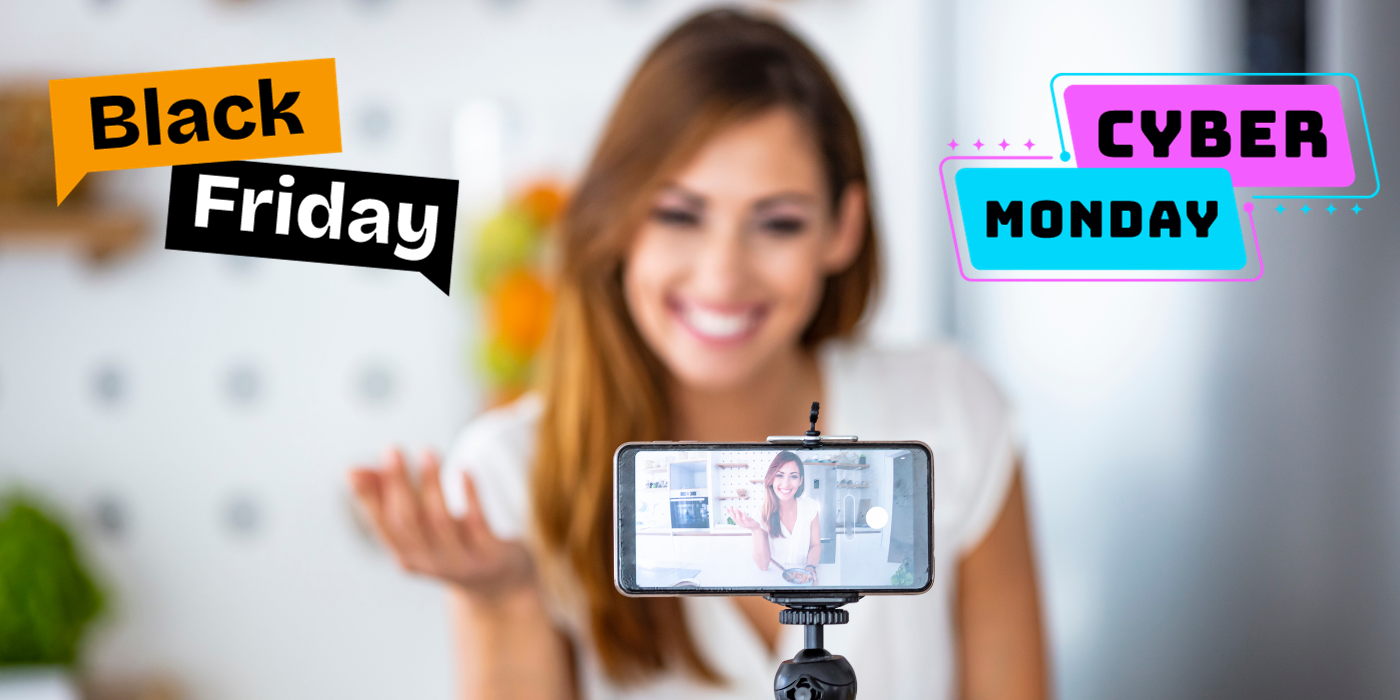
Blogs
Beyond Discounts: Crafting Winning Black Friday and Cyber Monday Marketing Strategies
November 20, 2023
Before standing in line for concerts was an era of standing in line for Black Friday shopping.
For millennials and Gen X, camping outside a big box retailer with hot chocolate, tents, and jackets in blistering cold November before stores opened at 5 a.m. was the norm.
This was eventually replaced as brands and retailers began to avoid the stampedes and physical rush in stores by offering deals online. And as that got popularized and Black Friday extended to become Cyber Weekend, the game changed drastically for shoppers and marketers alike.
Every year, Black Friday and Cyber Monday marketing evolves with trends. Consider this: According to the National Retail Federation, 87.2 million U.S. consumers shopped online on Black Friday in 2022.
These events mark the pinnacle of the U.S. shopping calendar, heralding the commencement of the holiday season. However, we are now experiencing the ripple effects of the COVID-19 pandemic and subsequent supply chain disruptions, followed by record-high inflation.
By analyzing historical data and anticipating future patterns, brands and retailers can strategically position Black Friday and Cyber Monday marketing strategies to navigate the holiday shopping season and leverage emerging trends that may impact their overall year-round strategy.
Here are four suggestions to ensure a successfully organized strategy leading up to the biggest weekend of the year.
1. Create a winning email marketing sequence, particularly for abandoned carts
While many will suggest pouring your marketing budget into paid social, don’t forget to leverage the power of email marketing to establish a direct line of communication with your already engaged audience, especially for Black Friday and Cyber Monday marketing.
Optimize this channel by crafting a compelling email sequence that includes key components, such as:
- Pre-sale announcements that prep loyal customers with purchase intent and reminders with sneak peeks of upcoming sales and offers
- Invitations to the Black Friday event, with clear announcement emails when the Black Friday sale begins
- Black Friday exclusive coupon codes for segmented audiences, ideally segmented by level of engagement
- Last-chance emails for offers ending soon, driving the urgency for impulse buys
Additionally, brands and retailers should ensure that abandoned carts are recovered over Cyber Weekend. Abandoned carts pose a significant challenge to retailers, with approximately 70% of shopping carts left neglected, according to the Baymard Institute. A reliable and proven method for reclaiming lost carts involves setting up an abandoned cart email sequence or automated workflow, which, when combined with Black Friday and Cyber Monday marketing, can stress the urgency and “limited-time deals” factor to amplify the sales.
2. Add live shopping to your BFCM marketing strategy
Live shopping events are gaining immense popularity in e-commerce, projected to be a $31 billion industry by the end of 2023. Livestream shopping enhances conversions, boosting sales with up to 70% higher average order value (AOV) and up to a 42% sales conversion rate. It also efficiently reaches the Gen Z and Gen Alpha demographics, which are growing. Incorporating a livestream shopping event or two could be a lucrative way to boost your revenue with an apt Black Friday and Cyber Monday marketing strategy.
To implement a livestream shopping event, brands and retailers can choose a livestreaming platform that aligns with their marketing goals, technical capabilities, and target audience. Many retailers find challenges in managing inventory on social platforms, leading to the off-platform growth of live commerce, fueled by the likes of Meta discontinuing live-shopping features. There are alternative platforms that enable retailers to host lives on their e-commerce sites directly, versus on social media, like buywith, amongst others.
These livestreams also serve as a way to demand and spur impulse purchases and witness sales in real time, especially around crowded, busy, and buzzy holidays. Introducing limited-time promotions and flash sales as part of a Black Friday and Cyber Monday marketing activity or live shopping event can spread awareness about the product offerings and sales and help answer questions to speed up the purchase cycle. Overall, livestream shopping can:
- Boost conversions through an immersive shopping experience: This enhances brand appeal and fosters customer connections.
- Provide immediate feedback and assistance: For example, audiences can ask the host common questions about product functionality, details of the sale, and recommendations during the livestream, thereby expediting their purchase.
- Deliver the emotional value of retail therapy: This brings the social shopping experience back into an otherwise solitary channel of online shopping, given that a livestream host brings a live interaction element to the experience.
As a bonus, brands and retailers can reuse livestreams for other Black Friday and Cyber Monday marketing promotions. According to buywith’s experience with brands and retailers repurposing their live shopping events, 87% of livestream revenue comes from replay views, making it an efficient and multi-pronged strategy.
3. Prep your influencer campaigns with clear objectives, especially as a livestream host
Nearly 90% of marketers attest to the ROI of influencer marketing being equal to or surpassing other channels. Whether engaging micro-influencers with modest followings and budget-friendly options or opting for large-scale influencers with millions of followers and higher price tags, influencer marketing can prove lucrative for retailers and brands as part of their Black Friday and Cyber Monday marketing strategies.
As aforementioned, the key to livestream commerce is having influencers who guide and steer discussions, wield influence, and persuade viewers to buy. Unlike solitary online shopping, livestream commerce is inherently communal, so live hosts must be well-trained and authentic. A strong host, whether a brand founder, a celebrity, an influencer, or a sales associate, is crucial for a successful, entertaining, and conversion-driven livestream. Most importantly, as the session is live and not pre-rehearsed, the brand or retailer has to ensure the livestream host is well-equipped with clear knowledge and objectives for the live session.
Having a clear objective for influencer marketing, particularly around a busy sales weekend, is key to a sound Black Friday and Cyber Monday marketing strategy. If the goal is awareness for newer brands, influencers need to be prepped with brand stories and gifting arrangements and aim for a more interactive, conversational outcome. If the objective is to highlight sales or drive traffic, an influencer’s success can be measured based on how many products they sell, on affiliate link clicks, or on sales associated with specific coupon code redemptions.
4. Create phygital campaigns to harness online, offline, and social commerce experiences
Post-pandemic, there has been a sharp rise in phygital retail experiences, blending physical elements with technology to meet evolving consumer expectations.
With more people returning to in-store shopping, retailers like Sephora, Ulta, DSW, and Best Buy have redesigned physical stores to mirror the convenience and popular elements of the online experience. These updates play a key role in amplifying sales during this busy weekend and affect a retailer’s Black Friday and Cyber Monday marketing strategy, as the goal is to drive traffic to websites and stores alike. Robust apps also play a crucial role, allowing shoppers to preview inventory, do virtual try-ons, and access personalized promotions. Immersive in-store experiences are becoming more prevalent in general, creating unique and tailored experiences for shoppers.
Personalization is essential here, both in-store and through apps, reflecting the importance of emotional drivers in consumer loyalty. Loyalty has historically been tied to exceptional customer service, data privacy, personalization, and brand values, but in an era when there are so many brands and retailers clamoring for attention, especially during Cyber Weekend, familiarity plays a crucial role. So when a Sephora or an Ulta Beauty redesigns its store, hosts a livestream shopping event from the store, and posts it on its website and social media platforms — like this livestream from Ulta with Dior — there is a visual synthesis for all audiences. This makes it easier for customers to passively align with the brand they are shopping with.
Final thoughts
Overall, Cyber Weekend is a test for all brands and retailers to effectively manage the implosion of traffic to their physical and e-commerce stores. Having a sound, multi-pronged Black Friday and Cyber Monday marketing strategy will ensure that they can maximize revenue and sales while maintaining customer loyalty and keeping things engaging and entertaining in the process.

